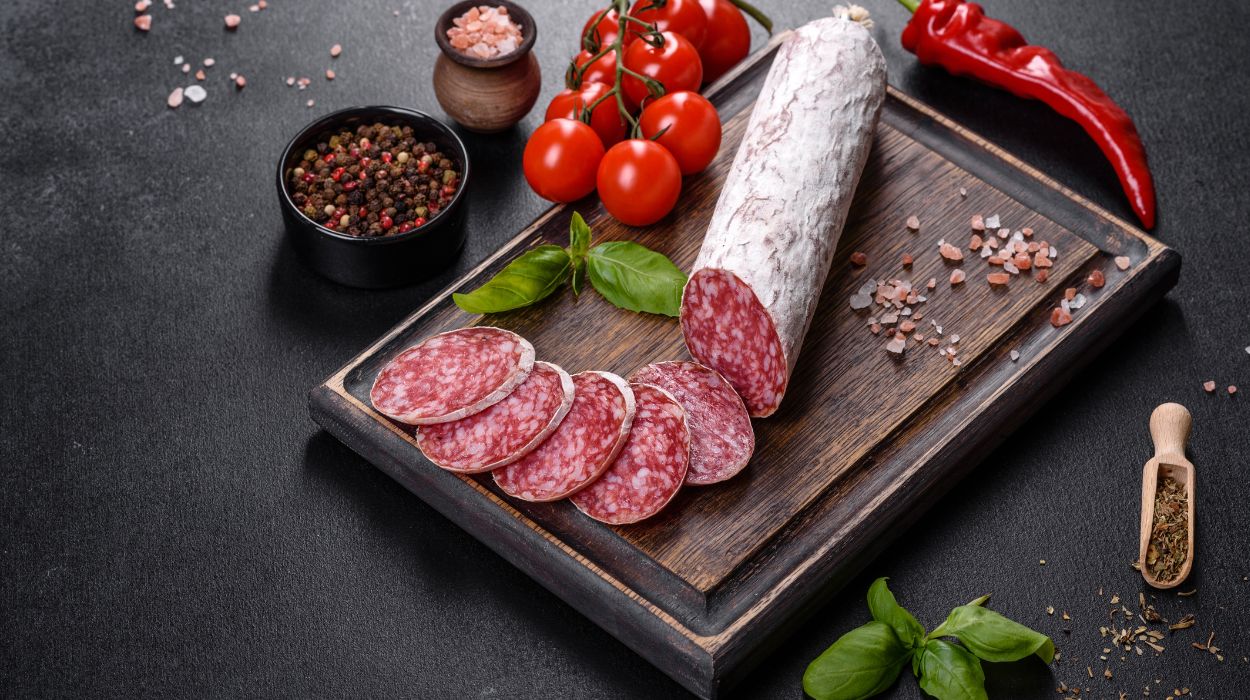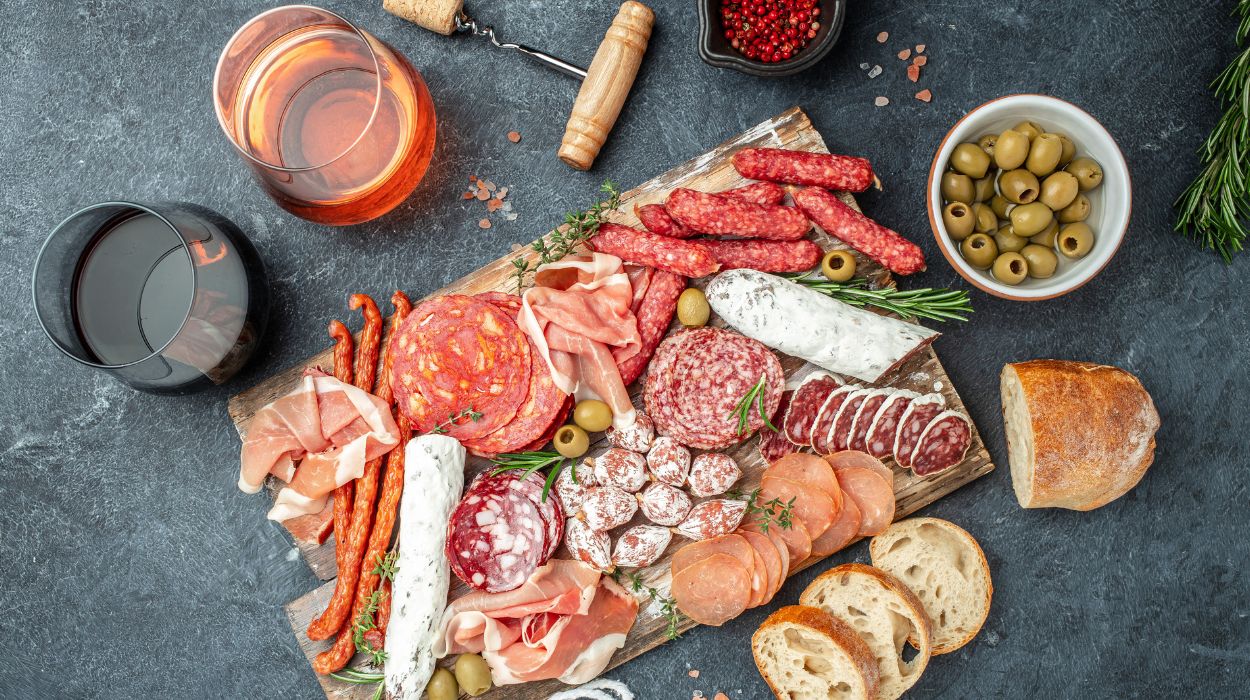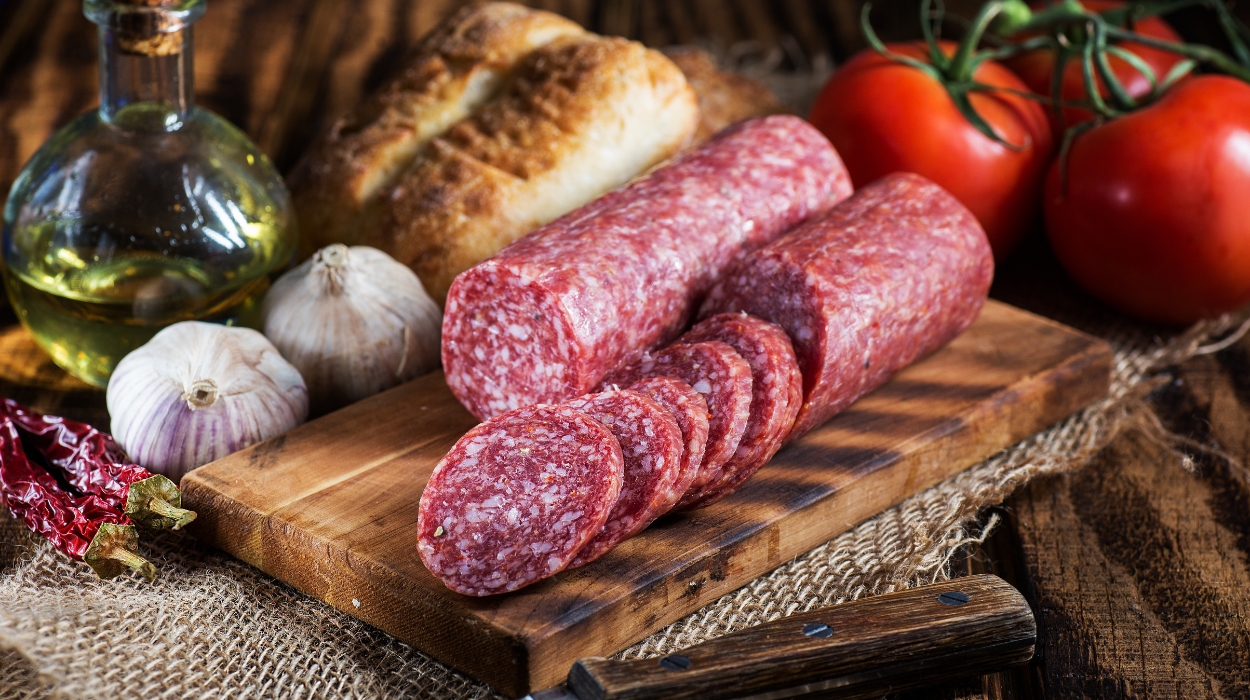Salami is a type of processed meat that is high in calories, saturated fat, and sodium. It doesn’t seem like a healthy food to eat to lose weight, but some say salami has weight loss benefits.
For most people, salami is an indulgence and not something you should eat when you’re counting calories. However, people on low-carb diets argue otherwise and claim salami is the perfect keto-friendly snack.
So, is salami good for weight loss or not?
Is Salami Healthy For Weight Loss?
Salami is not typically healthy for weight loss, as it is high in sodium, calories, and saturated fat. Eating a lot of salami can contribute heavily to your fat and calorie intake and may even lead to weight gain. However, people on low-carb or ketogenic diets may eat small amounts of salami and continue to lose weight on their diet. Still, if you’re on a weight loss journey, you should limit your intake of salami and other processed foods.
Is Salami Good For Weight Loss?

Reducing your daily calorie intake is the most important factor[1] for weight loss. Eating fewer calories than you burn will force your body to use its fat stores for energy. Unless you have a medical condition that prohibits weight loss, this will lead to a gradual reduction in body fat.
Salami and other processed meats are very high in calories and, therefore, not conducive to a calorie-restricted diet. Eating a slice or two won’t contribute significantly to your overall calorie intake, but it’s unlikely to satisfy your hunger pangs.
Feeling full after a snack is very important for people on a weight loss journey. Adequately satiating snacks can help suppress the urge to overeat,[2] which is key for maintaining a calorie deficit. Eating small amounts of salami may not satisfy food cravings, and you could end up eating more to compensate.
For dieters, low-calorie foods like fruits and vegetables, whole grains, and lean meats are more conducive to weight loss. High-protein foods like Greek yogurt, peanut butter, and eggs can make snacks more satisfying[3] and curb your desire to eat more.
So, is hard salami good for weight loss? Salami and other deli meats can be enjoyed as an occasional treat, but they probably won’t help you lose weight. Just 1 ounce of salami contains more calories[4] than a whole large apple[5] or 1 oz of air-popped popcorn.[6]
What Is Salami?
Salami is a type of cured sausage widely consumed in Italy, Spain, and Germany.[7] Traditional salami is made from a combination of beef or pork and minced fat that’s seasoned with salt, garlic, herbs, spices, or vinegar. The raw meat mixture is fermented for a day or more, then stuffed into a natural casing and hung up to cure.
Curing is a process in which meat is treated[8] with either potassium or sodium nitrate or potassium or sodium nitrite. This flavors and preserves the meat, preventing the growth of harmful bacteria and increases its shelf life. Cured salami is typically sold ready to eat.
Curing is a preservation method that dates back over 5000 years.[9] Before refrigerators, meat was rubbed with salt to prevent it from spoiling.
Nutritional Value Of Salami
One ounce of salami contains[4] 119 calories, 6.1 grams of protein, and 10.4 grams of fat. It also contains important nutrients like calcium, magnesium, phosphorus, potassium, zinc, and B vitamins.
Salami contains up to 35% fat,[10] most of which is saturated fat. It is also very high in salt, with a single portion contributing almost a quarter of your Daily Value of less than 2,300 mg sodium.[11]
Should You Eat Salami On A Weight Loss Diet?

Usually, the best meats for weight loss are lean cuts of chicken, turkey, or pork. However, people on low-carb diets may enjoy salami as a high-energy, keto-friendly snack.
The ketogenic diet is a very low-carbohydrate, high-fat diet that has gained massive popularity over the last decade. The purpose of this diet is to induce ketosis, where the body burns fat-derived ketones[12] for energy rather than glucose. Ketosis is a metabolic state that promotes the breakdown of fat stores and often leads to significant short-term weight loss.[13]
The ketogenic diet plan limits carbohydrate intake to less than 50 grams per day,[14] as eating more than this could disrupt ketosis. Instead, keto dieters get the energy their bodies need from fat and protein.
Keto-friendly snacks include foods like eggs, nut butter, seeds, olives, and beef jerky. Salami also fits the nutritional profile of the ketogenic diet, as it is high in fat and protein. Therefore, salami and other cured meats may aid weight loss in people on low-carb, high-fat diets.
If you think you’d benefit from a fat burner but don’t want to go ketogenic, consider trying diet pills under the guidance of your doctor. Many diet pills contain active compounds that promote weight loss by increasing metabolism, suppressing appetite, and stimulating fat-burning processes.
Potential Drawbacks Of Eating Salami
Eating salami and other cured meats can significantly increase your sodium intake, which may be detrimental to your health.
High sodium diets are associated with[15] high blood pressure and increased risk of cardiovascular disease. Eating too much salt may also[16] disrupt brain function, impair your memory, and alter sleep patterns. For this reason, the FDA recommends[11] an intake of less than 2,300 mg of sodium daily.
The sodium nitrate used to cure salami may also have negative health effects. This is because nitrates are thought to have carcinogenic properties and may increase your risk[17] of stomach cancer, colon cancer, and esophageal cancer. However, there is a need for more research.
Salami is generally safe to eat, but improper handling of the product can introduce foodborne pathogens[18] like Listeria monocytogenes. Listeria monocytogenes is a major cause of food poisoning[19] and can cause symptoms like vomiting, diarrhea, and mild fever. Outbreaks of Listeria poisoning are relatively rare, but you should buy salami from reputable shops to reduce your risk of illness.
Excessive consumption of meat products, especially processed meat, is generally bad for your health. Salami also has a high fat and calorie content, so eating too much can contribute to weight gain. Therefore, you should enjoy salami and other deli meats as an occasional treat.
Possible Health Benefits Of Salami
Excessive processed meat consumption can be detrimental to your health, but occasionally eating salami could have some health benefits.
This is because salami contains several essential nutrients, including[4] calcium, magnesium, phosphorus, potassium, zinc, and B vitamins. Vitamins and minerals support every biological process[20] that takes place in your body, including metabolism, DNA synthesis, and oxygen transport. Therefore, getting adequate micronutrients in your diet is key for keeping your body strong and healthy.
Some types of salami are also supplemented with probiotics.[21] These are live, beneficial bacteria that may support digestion and benefit your overall health. Probiotics can help prevent bowel diseases,[22] boost your immune health, improve your blood pressure, and address digestive issues like diarrhea.
Conclusion
Salami is a popular item for charcuterie boards, but it’s high fat content and calorie count make it unsuitable for most weight loss diets. People on low-carb diets may snack on salami to maintain ketosis, but eating too much can lead to weight gain. Therefore, salami is generally a food to avoid when losing weight.
Salami also has a very high sodium content, which can be detrimental to heart health. Eating a high-sodium diet can increase blood pressure and raise your risk of cardiovascular disease. Salami also contains nitrates and nitrites, two additives that may increase your cancer risk[17] if eaten in excess.
Salami and other cured meats are safe to enjoy now and then, but you should avoid eating them every day. If you’re dieting, snacking on fruits, vegetables, nuts, seeds, yogurt, or eggs may be healthier and more conducive to weight loss.
Frequently Asked Questions
As a high-calorie, high-fat food, salami is not generally recommended for people trying to lose weight. Salami may be suitable for people on ketogenic diets, but it won’t aid weight loss when eaten in excess.
Salami is high in calories, saturated fat, and sodium, so it’s not considered a healthy food. However, it does contain several essential nutrients, including calcium, magnesium, phosphorus, potassium, zinc, and B vitamins.
The best meats for losing weight are lean cuts of pork, chicken, and turkey. These meat products are high in protein and low in fat, so they won’t significantly contribute to your daily calorie intake.
Salami is a high-fat product, so eating lots of salami can contribute to weight gain. Increasing your body fat percentage will eventually bulk up all your body parts, including your belly.
Salami is made with uncooked meat. However, the curing process preserves meat and prevents the growth of foodborne pathogens, making it safe for consumption.
Salami is traditionally made with pork, but it can also be made with beef or poultry.
Salami is typically preserved using sodium nitrate and sodium nitrite. The manufacturer will often add other herbs and spices for flavor, including garlic, celery powder, onion powder, black pepper, mustard seed, and fennel seeds.
Salami is cured using two chemical additives called sodium nitrate and sodium nitrite. They are essential for the curing process, but excessive consumption of nitrates and nitrites may be linked to an increased risk of cancer.
 Evidence Based
Evidence Based
